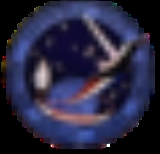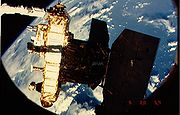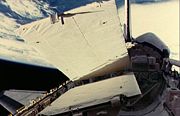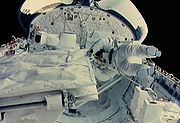
STS-41-G
Encyclopedia
STS 41-G was the 13th flight of NASA
's Space Shuttle program
and the sixth flight of Space Shuttle Challenger
. Challenger launched on 5 October 1984, and conducted the second shuttle landing at Kennedy Space Center
on 13 October. It was the first shuttle mission to carry a crew of seven, including the first crew with two women (Sally Ride
and Kathryn Sullivan), the first American EVA
involving a woman (Sullivan), and the first Canadian astronaut (Marc Garneau
).
STS-41-G was the third shuttle mission to carry an IMAX
camera on board to document the flight. Film footage from the mission (including Sullivan and Leestma's EVA) appeared in the IMAX movie The Dream is Alive
.


 On 5 October 1984, Challenger launched from Kennedy Space Center
On 5 October 1984, Challenger launched from Kennedy Space Center
at 7:03 am EDT, marking the start of the STS 41-G mission. It was Challengers sixth mission, and the 13th liftoff in the Space Shuttle
program.
On board were seven crew members—the largest flight crew ever to fly on a single spacecraft at that time. They included commander Robert L. Crippen, making his fourth Shuttle flight and second in six months; pilot Jon A. McBride; three mission specialists – David C. Leestma, Sally K. Ride and Kathryn D. Sullivan
– (the first time two female astronauts had flown together); and two payload specialists, Paul Scully-Power and Marc Garneau
, the first Canadian citizen to serve as a Shuttle crew member, as well as the first Canadian in space.
Astronaut Sullivan became the first American woman to walk in space when she and David C. Leestma performed a 3-hour EVA
on 11 October 1984, demonstrating the Orbital Refueling System (ORS) and proving the feasibility of refueling satellites in orbit.
Nine hours after liftoff, the 5087 lbs Earth Radiation Budget Satellite (ERBS) was deployed from the payload bay by the RMS robot arm, and its on-board thrusters boosted it into orbit 350 miles (563.3 km) above the Earth. The ERBS was the first of three planned satellites designed to measure the amount of energy received from the Sun
and reradiated into space. It also studied the seasonal movement of energy from the tropics
to the polar
regions.
Another major mission activity was the operation of the Shuttle Imaging Radar-B (SIR-B). The SIR-B was part of the OSTA-3 experiment package in the payload bay, which also included the Large Format Camera (LFC) to photograph Earth, another camera called MAPS which measured air pollution, and a feature identification and location experiment called FILE, which consisted of two TV cameras and two 70 mm still cameras.
The SIR-B was an improved version of a similar device flown on the OSTA-l package during STS-2
. It had an eight-panel antenna array measuring 35 feet by 7 feet (11 m by 2 m). It operated throughout the flight, but problems were encountered with Challenger’s Ku band
antenna, and therefore much of the data had to be recorded on board the orbiter rather than transmitted to Earth in real-time as was originally planned.
Payload Specialist Scully-Power, an employee of the U.S. Naval Research Lab, performed a series of oceanography
observations during the mission. Garneau conducted a series of experiments sponsored by the Canadian government, called CANEX, which were related to medical, atmospheric, climatic, materials and robotic science. A number of GAS
canisters, covering a wide variety of materials testing and physics experiments, were also flown.
The Soviet Terra-3
laser testing center was used to track Challenger with a low power laser
on 10 October 1984. This caused malfunction of on-board equipment and temporary blinding of the crew, leading to a U.S. diplomatic protest.
During the 8-day, 5-hour, 23-minute, 33-second mission, Challenger traveled 3289444 miles (5,293,833.8 km) and completed 132 orbits. It landed at the Shuttle Landing Facility at Kennedy Space Center
– becoming the second shuttle mission to land there - on 13 October 1984, at 12:26 pm EDT.
of the mission insignia symbolize the flight's numerical designation in the Space Transportation System's mission sequence (the 17 stars in the black field were indicative of the flight's original designation as STS-17). Gender symbols are placed next to each astronaut's name, and a Canadian flag
icon is placed next to Garneau's name.
.
. Each track is specially chosen, often by the astronauts' families, and usually has a special meaning to an individual member of the crew, or is applicable to their daily activities.
NASA
The National Aeronautics and Space Administration is the agency of the United States government that is responsible for the nation's civilian space program and for aeronautics and aerospace research...
's Space Shuttle program
Space Shuttle program
NASA's Space Shuttle program, officially called Space Transportation System , was the United States government's manned launch vehicle program from 1981 to 2011...
and the sixth flight of Space Shuttle Challenger
Space Shuttle Challenger
Space Shuttle Challenger was NASA's second Space Shuttle orbiter to be put into service, Columbia having been the first. The shuttle was built by Rockwell International's Space Transportation Systems Division in Downey, California...
. Challenger launched on 5 October 1984, and conducted the second shuttle landing at Kennedy Space Center
Kennedy Space Center
The John F. Kennedy Space Center is the NASA installation that has been the launch site for every United States human space flight since 1968. Although such flights are currently on hiatus, KSC continues to manage and operate unmanned rocket launch facilities for America's civilian space program...
on 13 October. It was the first shuttle mission to carry a crew of seven, including the first crew with two women (Sally Ride
Sally Ride
Sally Kristen Ride is an American physicist and a former NASA astronaut. Ride joined NASA in 1978, and in 1983 became the first American woman—and then-youngest American, at 32—to enter space...
and Kathryn Sullivan), the first American EVA
Extra-vehicular activity
Extra-vehicular activity is work done by an astronaut away from the Earth, and outside of a spacecraft. The term most commonly applies to an EVA made outside a craft orbiting Earth , but also applies to an EVA made on the surface of the Moon...
involving a woman (Sullivan), and the first Canadian astronaut (Marc Garneau
Marc Garneau
Joseph Jean-Pierre Marc Garneau, CC CD FCASI MP is a Canadian retired military officer, former astronaut, engineer and politician.Garneau was the first Canadian in space taking part in three flights aboard NASA Space shuttles...
).
STS-41-G was the third shuttle mission to carry an IMAX
IMAX
IMAX is a motion picture film format and a set of proprietary cinema projection standards created by the Canadian company IMAX Corporation. IMAX has the capacity to record and display images of far greater size and resolution than conventional film systems...
camera on board to document the flight. Film footage from the mission (including Sullivan and Leestma's EVA) appeared in the IMAX movie The Dream is Alive
The Dream Is Alive
The Dream is Alive is an IMAX movie, released in June 1985, about NASA's Space Shuttle program. The film was narrated by Walter Cronkite, and directed by Graeme Ferguson.-Synopsis:...
.
Crew
Backup crew
Mission parameters
- MassMassMass can be defined as a quantitive measure of the resistance an object has to change in its velocity.In physics, mass commonly refers to any of the following three properties of matter, which have been shown experimentally to be equivalent:...
:- Orbiter Liftoff: 242780 lbs
- Orbiter Landing: 202266 lbs
- Payload: 18901 lbs
- PerigeePerigeePerigee is the point at which an object makes its closest approach to the Earth.. Often the term is used in a broader sense to define the point in an orbit where the orbiting body is closest to the body it orbits. The opposite is the apogee, the farthest or highest point.The Greek prefix "peri"...
: 218 miles (350.8 km) - Apogee: 243 miles (391.1 km)
- InclinationInclinationInclination in general is the angle between a reference plane and another plane or axis of direction.-Orbits:The inclination is one of the six orbital parameters describing the shape and orientation of a celestial orbit...
: 57° - PeriodOrbital periodThe orbital period is the time taken for a given object to make one complete orbit about another object.When mentioned without further qualification in astronomy this refers to the sidereal period of an astronomical object, which is calculated with respect to the stars.There are several kinds of...
: 92.0 min
Spacewalk
- Leestma and Sullivan – EVA 1
- EVA 1 Start: 11 October 1984
- EVA 1 End: 11 October 1984
- Duration: 3 hours, 29 minutes
Mission summary



Kennedy Space Center
The John F. Kennedy Space Center is the NASA installation that has been the launch site for every United States human space flight since 1968. Although such flights are currently on hiatus, KSC continues to manage and operate unmanned rocket launch facilities for America's civilian space program...
at 7:03 am EDT, marking the start of the STS 41-G mission. It was Challengers sixth mission, and the 13th liftoff in the Space Shuttle
Space Shuttle
The Space Shuttle was a manned orbital rocket and spacecraft system operated by NASA on 135 missions from 1981 to 2011. The system combined rocket launch, orbital spacecraft, and re-entry spaceplane with modular add-ons...
program.
On board were seven crew members—the largest flight crew ever to fly on a single spacecraft at that time. They included commander Robert L. Crippen, making his fourth Shuttle flight and second in six months; pilot Jon A. McBride; three mission specialists – David C. Leestma, Sally K. Ride and Kathryn D. Sullivan
Kathryn D. Sullivan
Kathryn Dwyer Sullivan is an American geologist and a former NASA astronaut. A crew member on three Space Shuttle missions, she is the first American woman to walk in space.-Education:...
– (the first time two female astronauts had flown together); and two payload specialists, Paul Scully-Power and Marc Garneau
Marc Garneau
Joseph Jean-Pierre Marc Garneau, CC CD FCASI MP is a Canadian retired military officer, former astronaut, engineer and politician.Garneau was the first Canadian in space taking part in three flights aboard NASA Space shuttles...
, the first Canadian citizen to serve as a Shuttle crew member, as well as the first Canadian in space.
Astronaut Sullivan became the first American woman to walk in space when she and David C. Leestma performed a 3-hour EVA
Extra-vehicular activity
Extra-vehicular activity is work done by an astronaut away from the Earth, and outside of a spacecraft. The term most commonly applies to an EVA made outside a craft orbiting Earth , but also applies to an EVA made on the surface of the Moon...
on 11 October 1984, demonstrating the Orbital Refueling System (ORS) and proving the feasibility of refueling satellites in orbit.
Nine hours after liftoff, the 5087 lbs Earth Radiation Budget Satellite (ERBS) was deployed from the payload bay by the RMS robot arm, and its on-board thrusters boosted it into orbit 350 miles (563.3 km) above the Earth. The ERBS was the first of three planned satellites designed to measure the amount of energy received from the Sun
Sun
The Sun is the star at the center of the Solar System. It is almost perfectly spherical and consists of hot plasma interwoven with magnetic fields...
and reradiated into space. It also studied the seasonal movement of energy from the tropics
Tropics
The tropics is a region of the Earth surrounding the Equator. It is limited in latitude by the Tropic of Cancer in the northern hemisphere at approximately N and the Tropic of Capricorn in the southern hemisphere at S; these latitudes correspond to the axial tilt of the Earth...
to the polar
Polar
- Science, technology, and mathematics :*Polar , a satellite launched by NASA in 1996*Polar , a strongly magnetic cataclysmic variable star system...
regions.
Another major mission activity was the operation of the Shuttle Imaging Radar-B (SIR-B). The SIR-B was part of the OSTA-3 experiment package in the payload bay, which also included the Large Format Camera (LFC) to photograph Earth, another camera called MAPS which measured air pollution, and a feature identification and location experiment called FILE, which consisted of two TV cameras and two 70 mm still cameras.
The SIR-B was an improved version of a similar device flown on the OSTA-l package during STS-2
STS-2
STS-2 was a Space Shuttle mission conducted by NASA, using the Space Shuttle Columbia. The mission launched on 12 November 1981. It was the second shuttle mission overall, and was also the second mission for Columbia...
. It had an eight-panel antenna array measuring 35 feet by 7 feet (11 m by 2 m). It operated throughout the flight, but problems were encountered with Challenger’s Ku band
Ku band
The Kμ band is a portion of the electromagnetic spectrum in the microwave range of frequencies. This symbol refers to —in other words, the band directly below the K-band...
antenna, and therefore much of the data had to be recorded on board the orbiter rather than transmitted to Earth in real-time as was originally planned.
Payload Specialist Scully-Power, an employee of the U.S. Naval Research Lab, performed a series of oceanography
Oceanography
Oceanography , also called oceanology or marine science, is the branch of Earth science that studies the ocean...
observations during the mission. Garneau conducted a series of experiments sponsored by the Canadian government, called CANEX, which were related to medical, atmospheric, climatic, materials and robotic science. A number of GAS
Getaway Special
Getaway Special was a NASA program that offered interested individuals, or groups, opportunities to fly small experiments aboard the Space Shuttle...
canisters, covering a wide variety of materials testing and physics experiments, were also flown.
The Soviet Terra-3
Terra-3
Terra-3 is a laser testing centre, located on the Sary Shagan anti-ballistic missile testing range in Karagandy Province of Kazakhstan. -Development:...
laser testing center was used to track Challenger with a low power laser
Laser
A laser is a device that emits light through a process of optical amplification based on the stimulated emission of photons. The term "laser" originated as an acronym for Light Amplification by Stimulated Emission of Radiation...
on 10 October 1984. This caused malfunction of on-board equipment and temporary blinding of the crew, leading to a U.S. diplomatic protest.
During the 8-day, 5-hour, 23-minute, 33-second mission, Challenger traveled 3289444 miles (5,293,833.8 km) and completed 132 orbits. It landed at the Shuttle Landing Facility at Kennedy Space Center
Kennedy Space Center
The John F. Kennedy Space Center is the NASA installation that has been the launch site for every United States human space flight since 1968. Although such flights are currently on hiatus, KSC continues to manage and operate unmanned rocket launch facilities for America's civilian space program...
– becoming the second shuttle mission to land there - on 13 October 1984, at 12:26 pm EDT.
Mission insignia
The thirteen complete stars in the blue field of the U.S. flagFlag of the United States
The national flag of the United States of America consists of thirteen equal horizontal stripes of red alternating with white, with a blue rectangle in the canton bearing fifty small, white, five-pointed stars arranged in nine offset horizontal rows of six stars alternating with rows...
of the mission insignia symbolize the flight's numerical designation in the Space Transportation System's mission sequence (the 17 stars in the black field were indicative of the flight's original designation as STS-17). Gender symbols are placed next to each astronaut's name, and a Canadian flag
Flag of Canada
The national flag of Canada, also known as the Maple Leaf, and , is a red flag with a white square in its centre, featuring a stylized 11-pointed red maple leaf. Its adoption in 1965 marked the first time a national flag had been officially adopted in Canada to replace the Union Flag...
icon is placed next to Garneau's name.
Book
The STS 41-G mission was described in detail in the book Oceans to Orbit: The Story of Australia's First Man in Space, Paul Scully-Power by space historian Colin BurgessColin Burgess (author)
Colin Burgess is an Australian author and historian, specializing in space flight and military history. He is a former customer service manager for Qantas Airways, and a regular contributor to the collectSPACE online community. He lives in New South Wales...
.
Wake-up calls
NASA began a tradition of playing music to astronauts during the Gemini program, and first used music to wake up a flight crew during Apollo 15Apollo 15
Apollo 15 was the ninth manned mission in the American Apollo space program, the fourth to land on the Moon and the eighth successful manned mission. It was the first of what were termed "J missions", long duration stays on the Moon with a greater focus on science than had been possible on previous...
. Each track is specially chosen, often by the astronauts' families, and usually has a special meaning to an individual member of the crew, or is applicable to their daily activities.
| Flight Day | Song | Artist/Composer |
|---|---|---|
| Day 2 | "Flashdance – What A Feeling" | Irene Cara Irene Cara Irene Cara is an American singer and actress. Cara won an Academy Award in 1984 in the category of Best Original Song for co-writing "Flashdance... What a Feeling." She is also known for her recording of the song "Fame", and she also starred in the 1980 film Fame.She married Hollywood stuntman... |
| Day 3 | "Theme from Rocky Rocky Rocky is a 1976 American sports drama film directed by John G. Avildsen and both written by and starring Sylvester Stallone. It tells the rags to riches American Dream story of Rocky Balboa, an uneducated but kind-hearted debt collector for a loan shark in the city of Philadelphia, Pennsylvania... " |
See also
- Space explorationSpace explorationSpace exploration is the use of space technology to explore outer space. Physical exploration of space is conducted both by human spaceflights and by robotic spacecraft....
- Space ShuttleSpace ShuttleThe Space Shuttle was a manned orbital rocket and spacecraft system operated by NASA on 135 missions from 1981 to 2011. The system combined rocket launch, orbital spacecraft, and re-entry spaceplane with modular add-ons...
- List of space shuttle missions
- List of human spaceflights chronologically
External links
- NASA mission summary
- STS-41G Video Highlights
- The Dream is Alive IMAX film with footage from STS-41-G
- STS 41-G NST Program Mission Report

